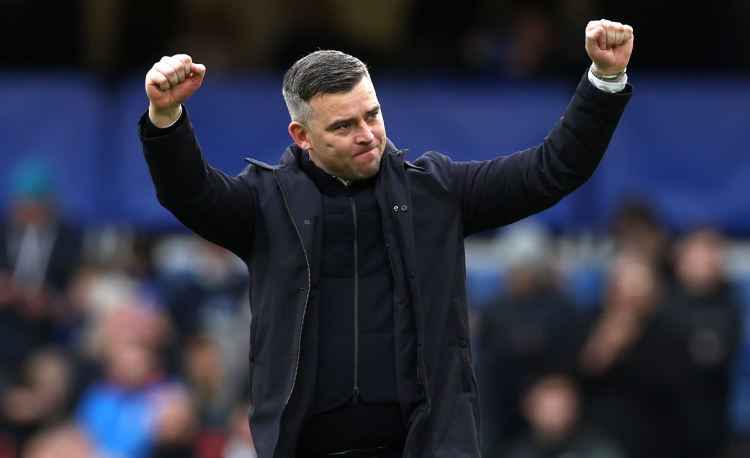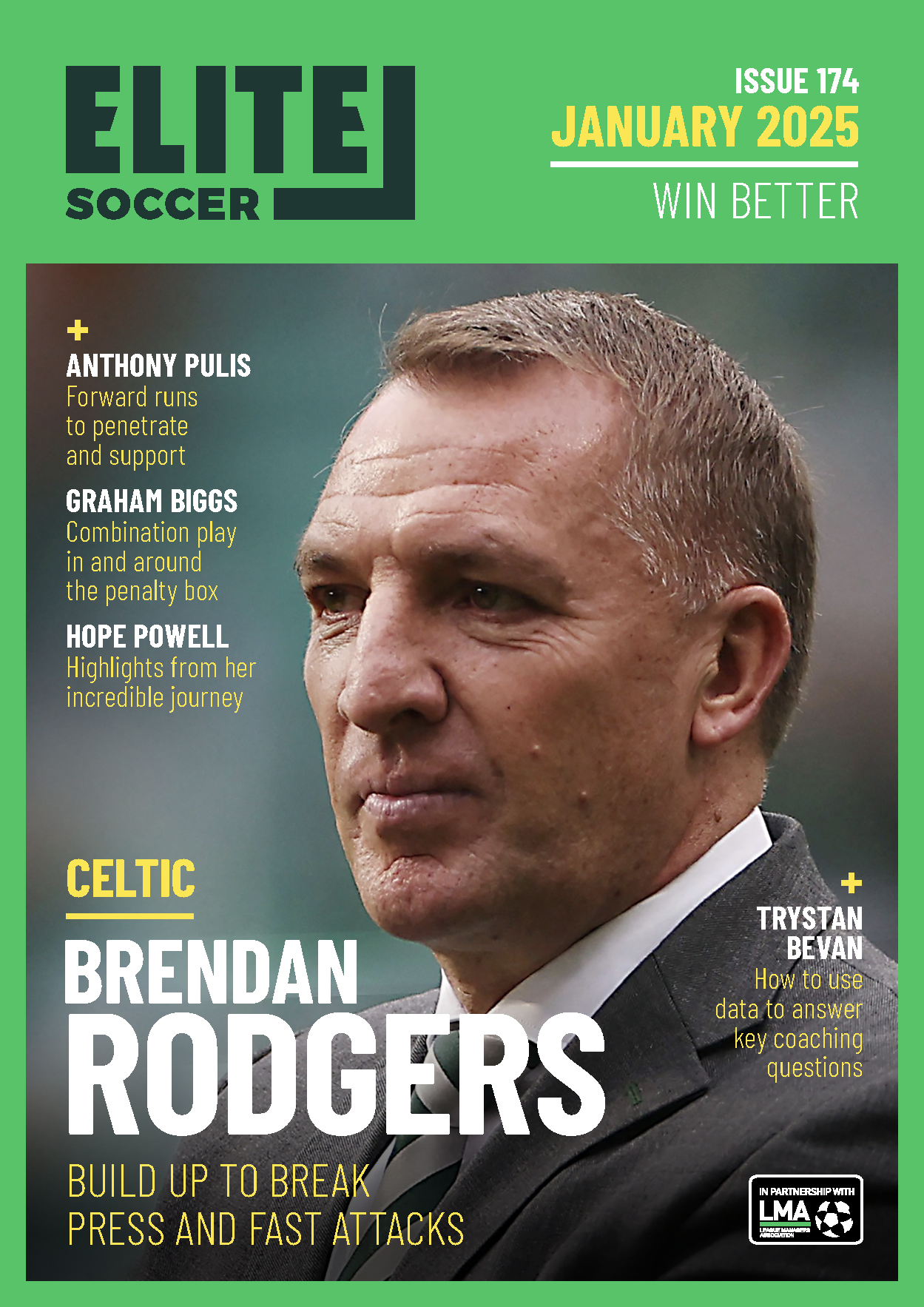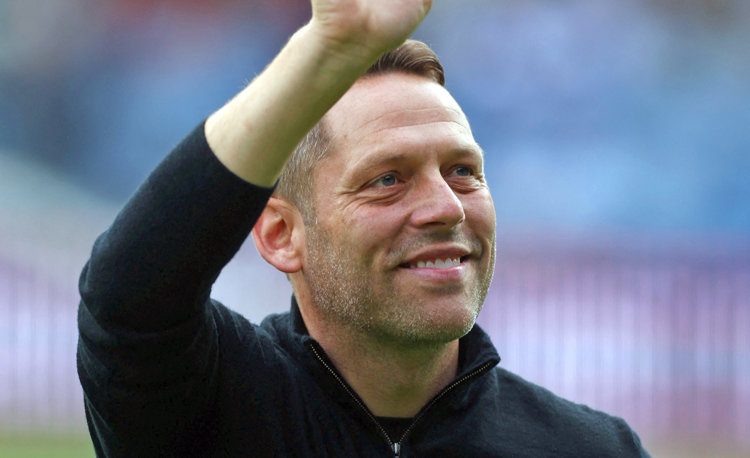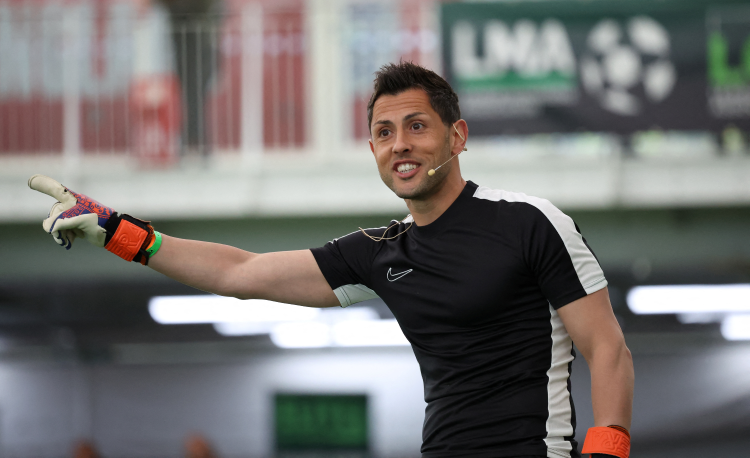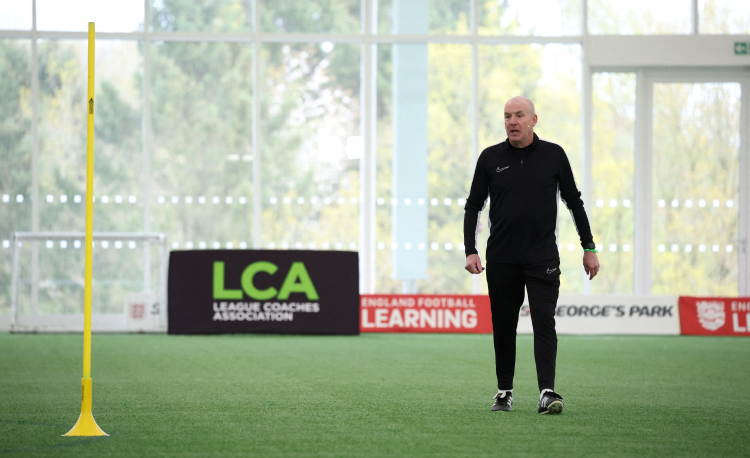You are viewing 1 of your 1 free articles
Counter-attacking
The session has two main focuses: counter attacking and exploiting overload situations and defensive principles, which will allow the opportunities to create turnovers and attempt counter attacks.
| Area | Over two-thirds of a full size pitch |
| Equipment | Balls, bibs, 2 full size goals, 4 mini goals |
| No. of Players | 23 outfield + 2 goalkeepers |
| Session Time |
S&C warm-up: 12mins |
The session has two main focuses: counter attacking and exploiting overload situations and defensive principles, which will allow the opportunities to create turnovers and attempt counter attacks.
There are two practices which will directly lead into the 11v11 preparation for a matchday. The sessions are all competitive, which will help the players’ focus and motivation. Each time the exercise is run we will look to add more tactical layers, to provide realistic match scenarios.
The practices have a phased progression. Starting with the mentality to attack and defend quickly in the first practice, then into a breakout possession which will create scenarios that give opportunities to attack quickly in an overload.
As there is a dual focus, it allows all players to visualise and experience something they may be required to do during a match.
We would look to utilise these types of practices on Match day -1 or -2 depending on when we would be doing this type of tactical work, as this can vary due to the physical demands and preparation time.
Often this would be for opponents where we may not be expected to have the majority of the possession, and who may carry a significant attacking threat, thus requiring the team to be more structured in their defensive set-up.
“As there is a dual focus, it allows all players to visualise and experience something they may be required to do during a match”
2v2 TARGET GAME
Following a 12-minute strength and conditioning warm-up [not shown], an area 24 yards long and 16 yards wide is set up, with two mini goals at each end. A total of 22 players are used, split into two teams of 10 – with two target players, one each based in the centre of either end. The teams line up from the corner of either end (five players in each) – reds from the left, blues from the right.
The red team start with the ball, with two players aiming to take on two opposing players. The reds work the ball into their attacking half. They look to then play the ball to the target player at the opposing end – who play it back for them to try and score. Once the ball is dead, all players exit the pitch [1a].
[1a]
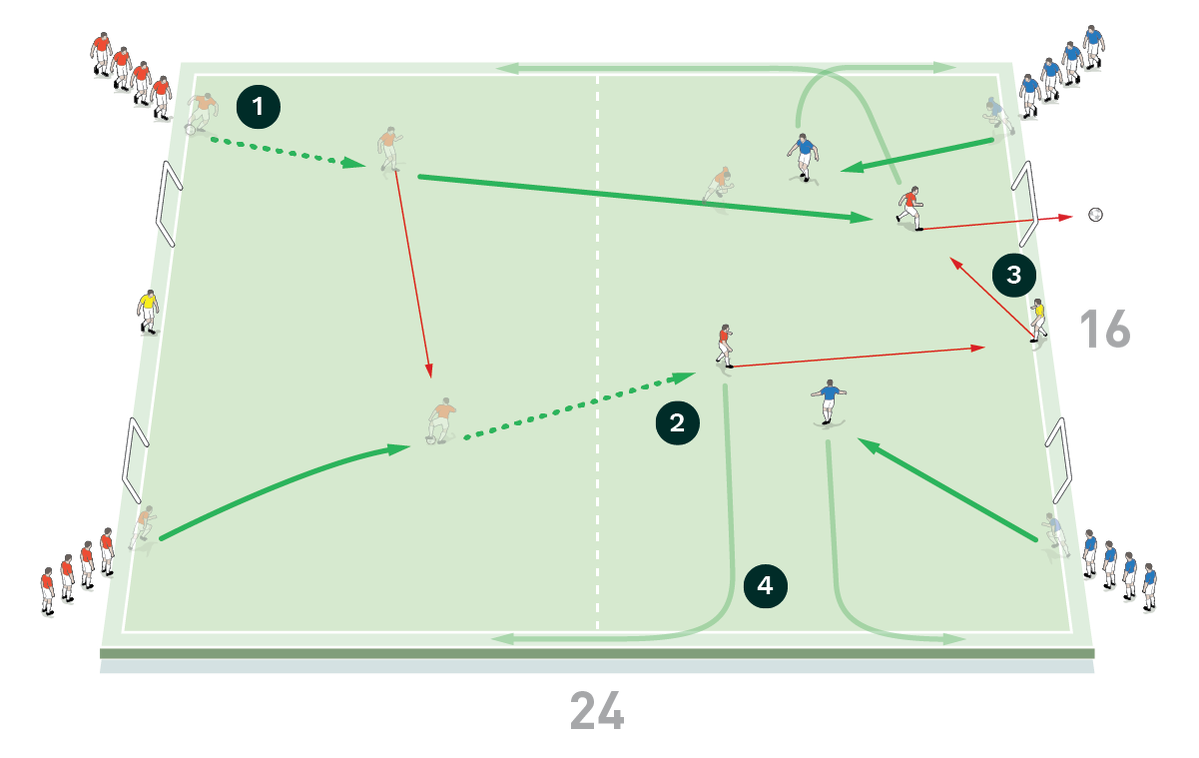
-
The red team start with the ball, with two players taking on two opposing blue players
- The reds work the ball into their attacking half
- They play the ball to a target player and receive it back to score
- Once the ball is dead all players exit the pitch
The blues now start with the ball, with four new players entering the pitch, two from either side.
“I want the players to think and play quick, and show quick reactions to transition”
The blues attack – but, in this instance, the reds steal the ball. They then counter-attack and score [1b].
[1b]

-
The blues now start with the ball, with four new players entering the pitch
- Two new reds enter the pitch
- The blues attack – but the reds steal the ball
The aim is for fast attacks, with forward passes and forward runs with and without the ball – while a team must be in the attacking half to score. The attacking team do not have to use a target player to score – but the target player can only take one touch in returning the ball to the passer. I want the players to think and play quick and show quick reactions to transition.
BREAK OUT POSSESSION
The pitch area is marked from penalty box to penalty box lengthwise, and the width of the penalty box is used, with a full size goal at each end. A 20-yard box also makes up the middle, and offside lines are marked out 25 yards in. We use 23 outfield players – two teams of 10 plus three floating players, with a goalkeeper in each goal.
Both teams are set up with two defenders and one striker outside the central square, with four players from each team inside it, plus three players on the side. One floating player starts in the square, with two others around it.
The blues start with the ball in the square with the aim of achieving five passes, while the reds look to win it back. One they have completed five passes they must look to find their striker either through progressing via a dribble or through a first-time pass. Two of the blues then join the striker to create a 3v2 overload, with the aim of working together to score a goal [2a].
[2a]
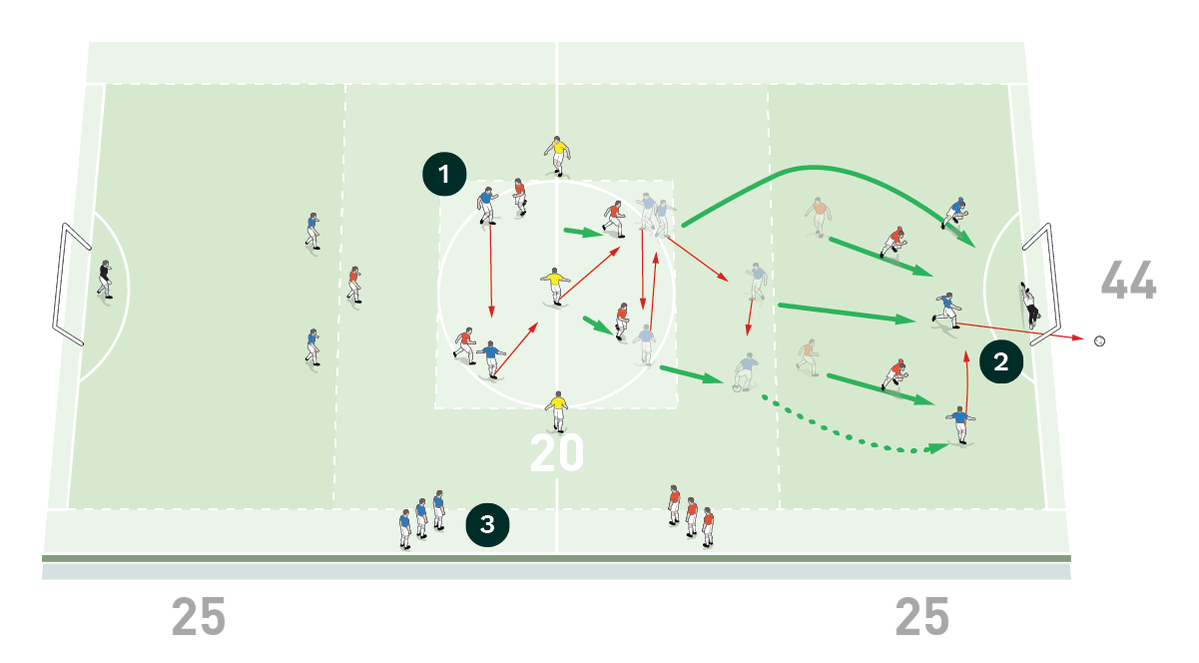
-
The blue team starts with the ball in the square, aiming to make five consecutive passes – while the reds look to win back possession
- Once they’ve completed five passes, the blues must find their striker, who is then joined by two team-mates to create a 3v2 overload with the aim to work together to score
- Once the attack is finished, two new players swap in with the two that attacked
Once the attack is completed, two new players swap in with the two that had joined the attack.
The reds now start with the ball, again, aiming to complete five passes before working the ball forward to their striker. Two players join to make a 3v2 in attack. However, in this example, the blue defenders win the ball and play it into the square to a team-mate, with the aim of then making five passes and sending play towards the other end of the pitch [2b].
[2b]
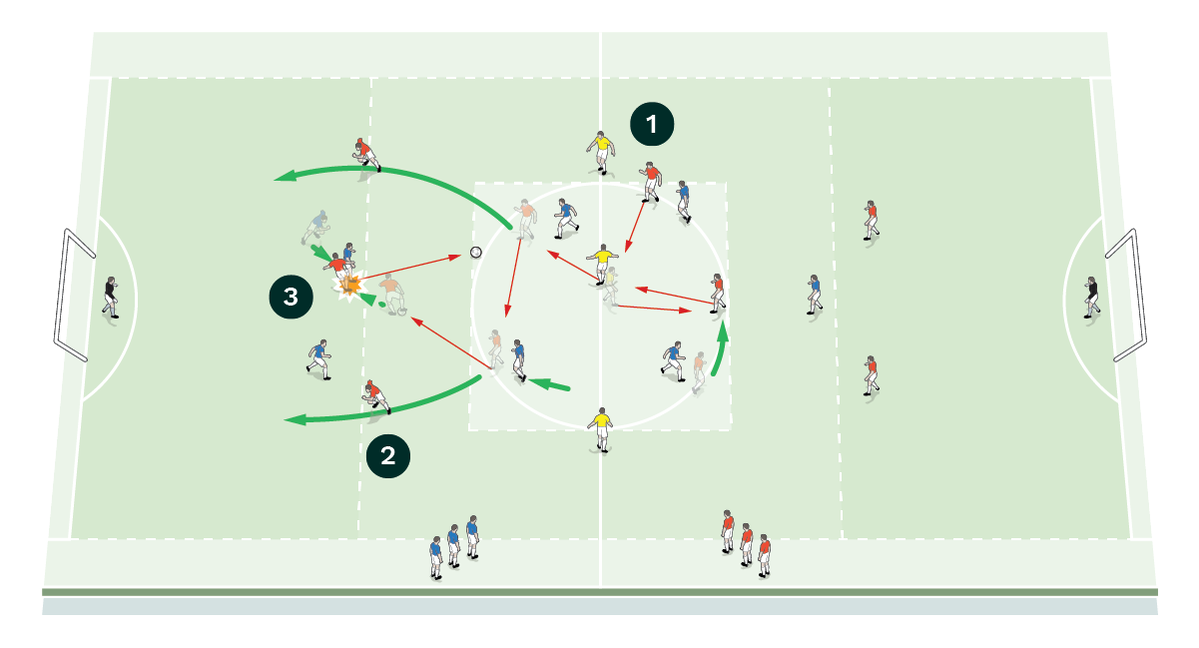
-
The reds now start with the ball, looking to play five passes and work the ball to their striker
- Two reds join the attack to make a 3v2
- The blue defenders win the ball and play it into the square for the blues to make five passes and send play the other way
For this exercise I will be looking for the teams to show composure in possession, especially in regains.
I want the players to always be looking to pass and run forward, always on the move to create space.
We run this exercise for three rounds of four minutes, with one minute rest between rounds.
Finally, we move into an 11v11 practice.
“I will allow the players to explore different ways of approaching the exercise in attack and defence, then intervene at the right time to highlight positives, or find opportunities to discuss and show alternatives to the decision they made”
COACHING POINTS
What are the key things to look out for?
Offensively, we will be looking for the players to show an ability to perform technical actions at speed – dribbling, passing, shooting, etc. Also, I’ll want them tactically recognising opportunities to create and exploit space, especially in the 3v2 scenarios.
Defensively, I will be looking at the distances between players to prevent successful through balls, so setting traps to be able to intercept. I also want the players to be switched on in recognising triggers to apply pressure on the ball (bad touch, square pass, etc).
What are the typical mistakes players might make and how do I avoid them?
Decision making on when to dribble or pass on counter-attacks are common things to look out for. When defending, playing can also become disconnected.
I will allow the players to explore different ways of approaching the exercise in attack and defence, then intervene at the right time to highlight positives, or find opportunities to discuss and show alternatives to the decision they made.
How would I put this in a game situation?
Counter attacking is a natural by-product of any game. Therefore, any size pitch with any number of players can be manipulated to encourage this type of tactic.
I want the players to always be looking to pass and progress forward, always on the move to create space.
Related Files
Steven Schumacher
Editor's Picks
Using the goalkeeper in build-up play
Pressing principles
Intensive boxes drill with goals
Penetrating the final third
Creating and finishing
My philosophy
Pressing initiation
Compact team movement
Defensive organisation
Coaches' Testimonials

Alan Pardew

Arsène Wenger

Brendan Rodgers

Carlos Carvalhal

José Mourinho

Jürgen Klopp

Pep Guardiola

Roy Hodgson

Sir Alex Ferguson

Steven Gerrard
Related
Coaches' Testimonials

Gerald Kearney, Downtown Las Vegas Soccer Club

Paul Butler, Florida, USA

Rick Shields, Springboro, USA

Tony Green, Pierrefonds Titans, Quebec, Canada
Join the world's leading coaches and managers and discover for yourself one of the best kept secrets in coaching. No other training tool on the planet is written or read by the calibre of names you’ll find in Elite Soccer.
In a recent survey 92% of subscribers said Elite Soccer makes them more confident, 89% said it makes them a more effective coach and 91% said it makes them more inspired.
Get Monthly Inspiration
All the latest techniques and approaches
Since 2010 Elite Soccer has given subscribers exclusive insight into the training ground practices of the world’s best coaches. Published in partnership with the League Managers Association we have unparalleled access to the leading lights in the English leagues, as well as a host of international managers.
Elite Soccer exclusively features sessions written by the coaches themselves. There are no observed sessions and no sessions “in the style of”, just first-hand advice delivered direct to you from the coach.
